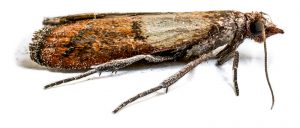EVER OPENED A CEREAL BOX OR FOOD CONTAINER AND FOUND IT FULL OF TINY BUGS?
Chances are you’ve discovered what are often called ‘pantry pests’. These are mostly small beetles and moths that live on a diet of flour, grains, nuts, cereals, seeds and biscuits.
They’ll spend most of their lives happily living, feeding and breeding within their food source, in your home or business.
Luckily, Pestpro has a treatment plan to manage these pests and prevent further infestations.
Simple Prevention
A serious worldwide problem in the process of getting food from farm to table, these pests are not uncommon in household kitchens.
High standards of hygiene and sanitation should be used to prevent the build-up of food materials in places like the corners of cupboards and under furniture.
Store food in sealed containers, discard anything unused for long periods and immediately dispose of any infested material.
Our Process
Pests commonly found in food, also known technically as stored product insects, covers a large number of insects. They can infest a variety of stored products in particular foodstuffs such as grains, cereals, dried fruit, nuts, seeds and even tobacco.
Stored grain insects are found in both private homes and businesses like food processing plants, warehouses, bakeries, stores, restaurants, mills, farms and silos. They can also cause enormous economic losses through damage and contamination of food products.
Identifying and removing the source of the infestation is a critical part of effectively controlling these pests.
Businesses like food processing or grain storage can greatly benefit from an ongoing professional pest management program to contain and eradicate infestations along with high standards of hygiene and sanitation, including stock rotation practices in accordance with any applicable regulations.
Any contamination will make your food unfit for human consumption.
There are many different species of moths, but home or business owners usually encounter pantry moths. These pests are attracted to a variety of household items, which they may use as a food source or a place to lay eggs.
Pantry moths, such as the Indian meal moth, eat dry goods, including grains, nuts, flours, spices, and chocolate. Clothes moths infest items like clothing and upholstery made of animal-based materials.
The extent of moth damage depends on the degree of infestation. A large population in the house can be quite costly, large amounts of food may need to be thrown away due to contamination from pantry moth webbing, cocoons, and droppings.
 Indianmeal Moths (Plodia Interpunctella)
Indianmeal Moths (Plodia Interpunctella)
Appearance
What do moths look like?
Wings: Moths typically have two pairs of wings covered in scales.
Eyes: They have a coiled proboscis and large compound eyes.
Size: Moths vary dramatically in appearance and size depending on the species. Some are massive and others tiny.
Colour: Certain species of moths are brilliant with metallic colours while other are drab in browns or grey.
Most indoor infesting moths are smaller than 2 cm wingspan and often are shades of grey or brown to reddish brown.


















